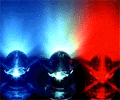A new type of light-emitting diode (LED) with significantly improved lighting performance and energy efficiency has been developed by researchers at Rensselaer Polytechnic Institute.
The new polarisation-matched LED, developed in collaboration with Samsung Electro-Mechanics, exhibits an 18 per cent increase in light output and a 22 per cent increase in wall-plug efficiency, which essentially measures the amount of electricity the LED converts into light.
The device also achieves a notable reduction in ‘efficiency droop’; this is a well-known phenomenon that causes LEDs to be most efficient when receiving low-density electric currents, but then to lose efficiency as higher-density currents are fed into the device. The cause of this droop is not yet fully understood, but studies have shown that electron leakage is likely to be a large part of the problem.
‘Droop is under the spotlight since today’s high-brightness LEDs are operated at current densities far beyond where efficiency peaks,’ said Rensselaer project leader Prof E Fred Schubert.
‘This challenge has been a stumbling block, because reducing the current densities to values where LEDs are more efficient is unacceptable. Our new LED, however, which has a radically redesigned active region, namely a polarisation-matched active region, tackles this issue and brings LEDs closer to being able to operate efficiently at high-density currents.’
Focusing on the active region of LEDs where the light is generated, Schubert’s team discovered the region contained materials with mismatched polarisation. The polarisation mismatch is likely to cause electron leakage, and therefore a loss of efficiency, Schubert said.
The researchers discovered that the polarisation mismatch can be strongly reduced by introducing a new quantum-barrier design. They replaced the conventional Gallium Indium Nitride/Gallium Nitride (GaInN/GaN) layer of the LED active region with Gallium Indium Nitride/Gallium Indium Nitride (GaInN/GaInN). This substitution allows the layers of the active region to have a better matched polarisation, and in turn reduce both electron leakage and efficiency droop.
The benefits seen by testing the new GaInN/GaInN LED were consistent with theoretical simulations showing polarisation matching reducing electron leakage and efficiency droop.

Band diagram of conventional GaInN/GaN active region and new polarisation-matched GaInN/GaInN active region of a light-emitting diode
Schubert expects that a new wave of lighting devices based on LEDs and solid-state lighting will supplant the common light bulb in coming years, leading to vast environmental, energy and cost benefits, as well as innovations in healthcare, transportation systems, digital displays and computer networking.




Glasgow trial explores AR cues for autonomous road safety
They've ploughed into a few vulnerable road users in the past. Making that less likely will make it spectacularly easy to stop the traffic for...